
|
2023 Annual National Data Report to Inform Trends and Patterns in Drug-Impaired Driving
|
This is the fourth annual report on trends and patterns in DID.
| 2024-06-14 |

|
Anniversary of the Release of the Mass Casualty Commission Final Report
|
In October 2020, Canada and Nova Scotia established the Joint Public Inquiry into the Nova Scotia April 2020 Tragedy (the “Mass Casualty Commission” or “the Commission”), led by the Honourable J. Michael MacDonald, former Chief Justice of Nova Scotia, Leanne J. Fitch (Ret. Police Chief, M.O.M.) and Dr. Kim Stanton.
| 2024-03-28 |

|
Crime Prevention in Indigenous Communities: An Examination of Culturally-Relevant Programs and Culturally-Competent Evaluation Approaches
|
This report reviewed and synthesized literature in response to two guiding research questions: how have Indigenous cultural practices, traditions, and activities been included in crime prevention programming and what is their connection with crime prevention; and, how have culturally-relevant crime prevention programs been evaluated and what is their contribution to crime prevention outcomes.
| 2023-12-20 |

|
Methods of Preventing Corruption: A Review and Analysis of Select Approaches
|
This literature review provides a comprehensive summary of methods commonly used to prevent corruption in both the private and public sectors and where possible, provides insight on which preventative methods have empirical value and demonstrated effectiveness.
| 2023-12-08 |

|
Research Summary - Methods of Preventing Corruption: A Review and Analysis of Select Approaches
|
This research summary provides a summary of methods commonly used to prevent corruption in both the private and public sectors and where possible, provides insight on which preventative methods have empirical value and demonstrated effectiveness.
| 2023-12-08 |

|
Final Report | Mass Casualty Commission
|
On March 30, 2023, the Mass Casualty Commission released its Final Report – Turning the Tide Together – in Truro, Nova Scotia and delivered to the Governors in Council of Nova Scotia and of Canada. The work of the Commission has now concluded.
| 2023-09-11 |

|
Examining Key Populations in the Context of Implementing Cyberbullying Prevention and Intervention Initiatives – Literature Review on 2SLGBTQ+, Girls and Ethno-racially Diverse
|
This document is a comprehensive report on existing cyberbullying literature, with a specific focus on 2SLGBTQ+, Girls, and Ethno-racially Diverse Youth.
| 2023-05-03 |

|
Research Summary: Examining Key Populations in the Context of Implementing Cyberbullying Prevention and Intervention Initiatives – Literature Review on 2SLGBTQ+, Girls and Ethno-racially Diverse
|
This document is a summary of a comprehensive report on existing cyberbullying literature, with a specific focus on 2SLGBTQ+, Girls, and Ethno-racially Diverse Youth.
| 2023-05-03 |

|
Examining Key Populations in the Context of Implementing Cyberbullying Prevention and Intervention Initiatives – The Role of the Family
|
This document is a comprehensive report on existing cyberbullying literature, with a specific focus on the role of families in cyberbullying prevention initiatives.
| 2023-03-06 |

|
Research Summary: Examining Key Populations in the Context of Implementing Cyberbullying Prevention and Intervention Initiatives – The Role of the Family
|
This document is a summary of a comprehensive report on existing cyberbullying literature, with a specific focus on the role of families in cyberbullying prevention initiatives.
| 2023-03-06 |

|
Evaluation of Risk Assessment Tools for Indigenous Individuals with a History of Sexual Crimes: A Response to Ewert case (2018)
|
This document examines how risk assessment tools for individuals with a history of sexual offences estimate the recidivism risk for Indigenous individuals, and whether they differ on risk-relevant characteristics compared to White individuals.
| 2023-02-24 |

|
Research Summary - Evaluation of Risk Assessment Tools for Indigenous Individuals with a History of Sexual Crimes: A Response to Ewert case (2018)
|
This document is a summary that examines how risk assessment tools for individuals with a history of sexual offences estimate the recidivism risk for Indigenous individuals, and whether they differ on risk-relevant characteristics compared to White individuals.
| 2023-02-24 |

|
Annual National Data Report to Inform Trends and Patterns in Drug-Impaired Driving 2022
|
Produced in cooperation with provinces, territories, the RCMP and CBSA, the report presents available data on what has been done to prevent, detect and deter drug-impaired driving.
| 2023-01-27 |

|
Mass Casualty Commission Interim Report
|
Joint Federal/Provincial Commission into the April 2020 Nova Scotia Mass Casualty
| 2022-05-20 |

|
Annual National Data Report to Inform Trends and Patterns in Drug-Impaired Driving 2021
|
This is the second annual report on trends and patterns in DID. It is produced in cooperation with the provinces and territories, the RCMP, CBSA, and other partner agencies and stakeholders.
| 2022-02-09 |

|
Large-Scale Implementation and Evaluation of the Strategic Training Initiative in Community Supervision (STICS)
|
The current study evaluated the system-wide implementation of the Strategic Training Initiative in Community Supervision (STICS) across British Columbia (BC)'s Community Corrections Division.
| 2021-08-04 |

|
Research Summary - Large-Scale Implementation and Evaluation of the Strategic Training Initiative in Community Supervision (STICS)
|
The current study evaluated the system-wide implementation of the Strategic Training Initiative in Community Supervision (STICS) across British Columbia (BC)'s Community Corrections Division.
| 2021-08-04 |

|
Research Summary - Crime Prevention Programs in Canada: Examining Key Implementation Elements for Indigenous Populations
|
This research study sought to examine the specific implementation issues for crime prevention programs aiming to serve Indigenous populations.
| 2021-05-18 |
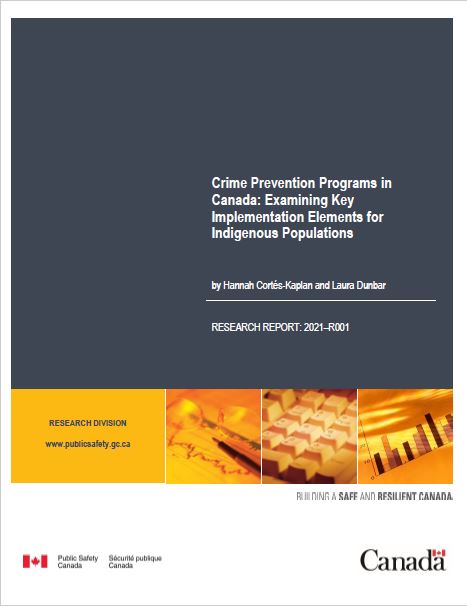
|
Crime Prevention Programs in Canada: Examining Key Implementation Elements for Indigenous Populations
|
This research study sought to examine the specific implementation issues for crime prevention programs aiming to serve Indigenous populations.
| 2021-05-18 |

|
Annual National Data Report to Inform Trends and Patterns in Drug-Impaired Driving
|
In the context of cannabis legalization, the Government of Canada introduced legislation to create new offences and provide additional tools to law enforcement to detect and deter drug-impaired driving (DID).
| 2021-01-20 |

|
Research Summary - Incorporating Gender-Based Analysis into Crime Prevention
|
This document provides a gender-based plus analysis of crime prevention programming to address gender issues and inform program implementers on gender-based risk assessments and interventions.
| 2020-11-19 |
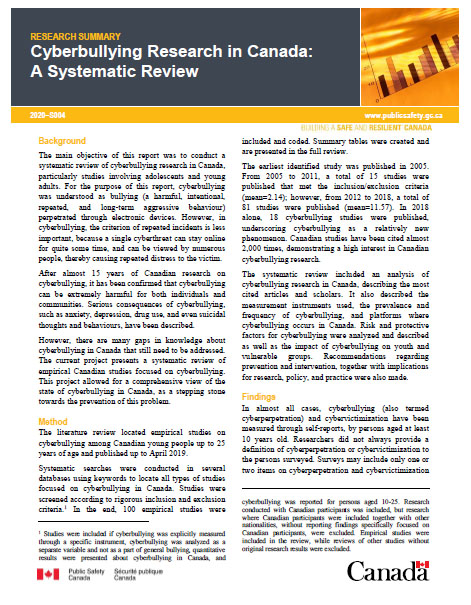
|
Research Summary - Cyberbullying Research in Canada: A Systematic Review
|
This document identifies the populations most vulnerable to being a victim or perpetrator of cyberbullying and their characteristics, as well as the contributing factors to cyberbullying.
| 2020-10-09 |

|
Research Summary - Cyberbullying Programs – An Environmental Scan
|
This document provides a comprehensive review of cyberbullying programs, including an overview of program components, implementation requirements and performance and evaluation measures of cyberbullying prevention and interventions.
| 2020-10-09 |

|
Profile of Canadian Businesses who Report Cybercrime to Police
|
This report examines the phenomenon of underreporting of cyber security incidents to police services using data from the 2017 Canadian Survey of Cyber Security and Cybercrime that was administered to Canadian businesses.
| 2020-02-14 |
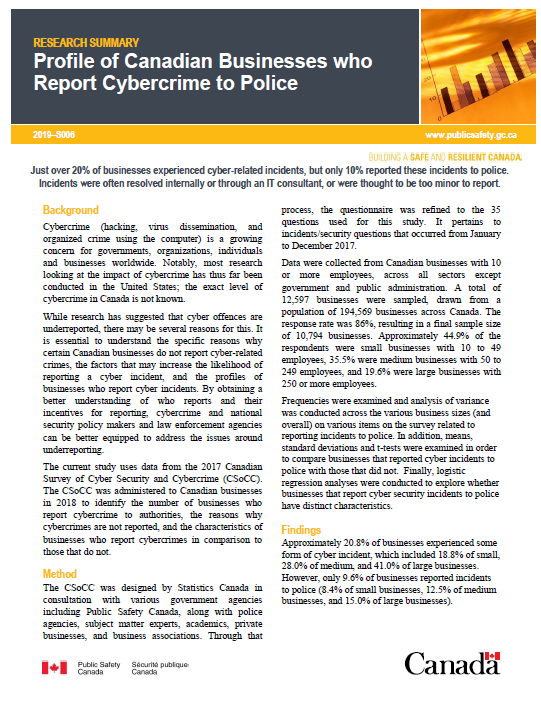
|
Research Summary - Profile of Canadian Businesses who Report Cybercrime to Police
|
This report examines the phenomenon of underreporting of cyber security incidents to police services using data from the 2017 Canadian Survey of Cyber Security and Cybercrime that was administered to Canadian businesses.
| 2020-02-14 |

|
Measuring Public Attitudes towards the Police – Technical Report
|
Currently, there is no common approach across Canada to measure public attitudes towards the police. The objective of this study was to develop empirically-informed indicators that can be used by Canadian police services for this purpose. This report is part of a larger project led by Public Safety Canada and Halifax Regional Police, in consultation with the policing community, to establish evidence-based indicators as a common data standard.
| 2019-06-21 |

|
Research Summary: Behaviours and Beliefs Related to Cannabis Before Legalization: A Public Safety Perspective
|
Over the past few years, the government of Canada has been preparing to legalize, regulate and restrict access to non-medical cannabis. Understanding the changes in perceptions and behaviours of those who use cannabis before and after the change in regime is important, as it will help to develop public safety policy and program initiatives, including education and crime prevention activities.
| 2019-06-18 |

|
Behaviours and Beliefs Related to Cannabis Before Legalization: A Public Safety Perspective
|
Over the past few years, the government of Canada has been preparing to legalize, regulate and restrict access to non-medical cannabis. Understanding the changes in perceptions and behaviours of those who use cannabis before and after the change in regime is important, as it will help to develop public safety policy and program initiatives, including education and crime prevention activities.
| 2019-06-18 |

|
The Canada Centre for Community Engagement and Prevention of Violence - What we heard
|
This report is based on the valuable feedback, ideas, opinions, and perspectives as submitted by contributors to the online public consultation. The information presented is directional in nature and as participation was on an open opt-in basis, the results should not be extrapolated to a broader audience.
| 2018-09-24 |

|
2017-2018 Evaluation of the National Crime Prevention Strategy
|
This report presents the results of the 2017-18 Evaluation of the National Crime Prevention Strategy (NCPS). The NCPS is the framework for crime prevention initiatives in Canada.
| 2018-09-20 |

|
Summary of the 2017-18 Evaluation of the National Crime Prevention Strategy
|
This report presents the results of the 2017-18 Evaluation of the National Crime Prevention Strategy (NCPS). The NCPS is the framework for crime prevention initiatives in Canada.
| 2018-09-20 |

|
National Consultations Discussion Paper: The Way Forward to End Human Trafficking
|
This Discussion Paper was prepared by Public Safety Canada in consultation with the federal Human Trafficking Taskforce. Its purpose is to elicit discussion and comments to inform the Government of Canada in the development of a new national strategy to end human trafficking.
| 2018-08-24 |

|
Sustainability Study: National Crime Prevention Strategy Programs
|
The purpose of this Sustainability Study was to determine the extent to which the National Crime Prevention Strategy's funded crime prevention projects were sustained following the five year funding period.
| 2018-08-07 |

|
Research Highlights - Crime Prevention: Local Adaptations of Crime Prevention Programs: A Toolkit
|
This toolkit is a summary of a larger project that consists of a broad literature review reflecting current theory, practice and knowledge on the local adaptation of intervention programs in a variety of disciplines.
| 2018-08-07 |

|
Research Summary - Local Adaptations of Crime Prevention Programs: A Toolkit
|
This is a summary of the document titled 'Research Highlights – Local Adaptations of Crime Prevention Programs: A Toolkit'.
| 2018-08-07 |
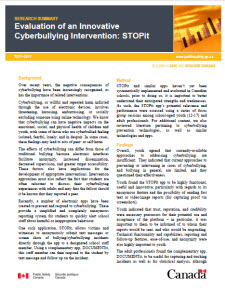
|
Research Summary: Evaluation Of An Innovative Cyberbullying Intervention: STOPit
|
This evaluation aimed to assess the potential relevance and performance of one innovative cyberbullying platform called STOPit.
| 2018-07-09 |

|
Evaluation of an Innovative Cyberbullying Intervention: STOPit: Summary Report
|
This evaluation aimed to assess the potential relevance and performance of one innovative cyberbullying platform called STOPit.
| 2018-07-09 |

|
Summit on Gun and Gang Violence: Summary Report
|
Firearm-related homicides in Canada have been steadily increasing, reaching a total of 223 in 2016, 44 more than the previous year. Shootings have now become the most common method of homicide, surpassing homicide by stabbing and beating.
| 2018-06-19 |
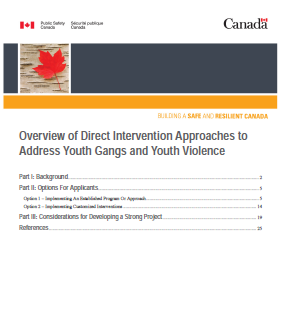
|
Overview of Direct Intervention Approaches to Address Youth Gangs and Youth Violence
|
Gang-involved youth are considered to be some of the main perpetrators (and victims) of crime and violence, and impose a high burden on society in terms of criminal justice system and other societal costs.
| 2018-06-11 |
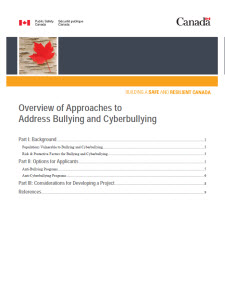
|
Overview of Approaches to Address Bullying and Cyberbullying
|
Bullying and cyberbullying are recognized globally as complex and serious problems that have significant negative health and social impacts. Prevention and intervention approaches that seek to address these problems can have an impact on the short- and long-term effects of bullying/cyberbullying others and/or experiencing victimization.
| 2018-06-11 |

|
How to best predict sexual reoffending among sex offenders
|
The research summary is a study that examined how best to predict the risk to reoffend among sex offenders.
| 2018-05-01 |

|
Child Pornography Offenders: A Review
|
The research summary is a review of the current state of knowledge on child pornography offenders, to determine implications for practice, and to highlight areas that are relevant for future research.
| 2018-05-01 |

|
Evaluation of the Alternative Suspension Program
|
The Alternative Suspension Program was first introduced by the YMCAs of Québec in 1999 in response to a request from a local school in Montréal. The ultimate goal of the intervention is to reduce criminal activity by increasing youth attachment to school.
| 2018-05-01 |

|
Evaluation of the Alternative Suspension Program
Research Report: 2017–R008
|
The Alternative Suspension Program was first introduced by the YMCAs of Québec in 1999 in response to a request from a local school in Montréal. The ultimate goal of the intervention is to reduce criminal activity by increasing youth attachment to school.
| 2018-05-01 |

|
Research Summary - Offender Risk Assessment Practices Vary Across Canada
|
What exactly does it mean when a correctional agency assesses an offender to be high risk?
| 2018-03-27 |

|
Research Highlights - Crime Prevention : Transitions From Juvenile Delinquency to Young Adult Offending: A Review of Canadian and International Evidence
|
This document reviews longitudinal research on key questions concerning transitions from juvenile delinquency to young adult offending.
| 2018-02-23 |

|
Research Summary - Transitions From Juvenile Delinquency to Young Adult Offending: A Review of Canadian and International Evidence
|
This review examines Canadian and international longitudinal studies concerning the transition from juvenile delinquency to young adult offending.
| 2018-02-23 |
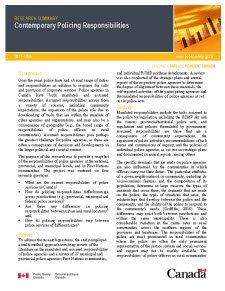
|
Research Summary - Contemporary Policing Responsibilities
|
The purpose of this research was to provide a snapshot of the responsibilities of police agencies at the national, provincial, and municipal levels, and in First Nations communities.
| 2018-02-23 |
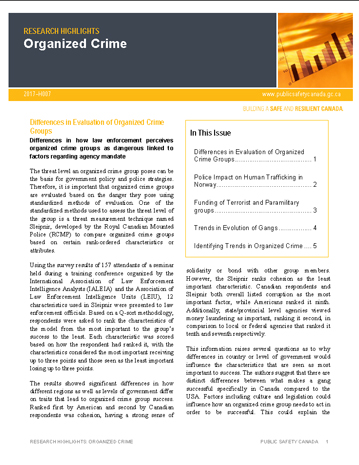
|
Organized Crime – Research Highlights 2017-H007
|
The study highlights the differences in evaluation of Organized Crime Groups; Police Impact on Human Trafficking in Norway; Funding of Terrorist and Paramilitary groups; Trends in Evolution of Gangs; Identifying Trends in Organized Crime.
| 2018-02-23 |

|
Research Summary: Review of Evidence-Based Registries Relevant to Crime Prevention
|
This report reviews American evidence-based registries relevant to crime prevention to assist in the development of a Canadian-specific system for rating the level of programs' effectiveness, as part of efforts to promote an evidence-based crime prevention agenda.
| 2018-01-10 |

|
Crime Prevention - Research Highlights 2017-H03-CP - Sports-Based Crime Prevention Programs
|
Supervised sports have been used in many countries as a strategy to address social issues such as youth crime and substance abuse. The following research highlights provides additional information on crime prevention using sports, including summaries of promising programs and initiatives both in Canada and internationally, key results, and lessons learned.”
| 2017-12-12 |

|
Research Summary: Programme de suivi intensif de Montréal – Gangs de rue [Montreal Intensive Supervision Program – Street Gangs]
|
Evaluation of the impact of an intensive supervision program on offending behaviours and criminogenic risks, social integration, and the level of engagement in street gangs among young offenders aged 15 to 25, including a descriptive cost analysis and a cost-effectiveness study.
| 2017-11-10 |

|
Crime Prevention - Research Highlights 2017-H02-CP - Community Readiness and Mobilization
|
These research highlights provide guidelines on the concepts of community readiness and mobilization in an effort to strengthen crime prevention efforts in Canada. These pro-active and adaptable models are explained in a practical sense to allow communities to identify and address the criminal, social or public health issues impacting them.
| 2017-10-02 |

|
Crime Prevention - Research Highlights 2017-H01-CP – Youth Mental Health, Mental Illness and Crime
|
The purpose of this report is to examine the Canadian knowledge concerning youth suffering from mental health disorders and their involvement in crime, with particular interest in the age group 12-24, to highlight the important correlations between mental health and some specific crime issues and to identify the knowledge gaps.
| 2017-09-26 |

|
2016-2017 Evaluation of the National Flagging System Program
|
The National Flagging System is a database as well as a network of provincial/territorial coordinators responsible for identifying high-risk offenders for flagging purposes. The evaluation examined the relevance (continued need and alignment with the federal government's roles, responsibilities and priorities) and performance (progress towards achievement of intended outcomes, efficiency and economy) of the National Flagging System over the period of 2012-13 to 2016-17.
| 2017-09-21 |

|
Summary of the 2016-2017 Evaluation of the National Flagging System Program (NFS)
|
The National Flagging System is a database as well as a network of provincial/territorial coordinators responsible for identifying high-risk offenders for flagging purposes. The evaluation examined the relevance (continued need and alignment with the federal government's roles, responsibilities and priorities) and performance (progress towards achievement of intended outcomes, efficiency and economy) of the National Flagging System over the period of 2012-13 to 2016-17.
| 2017-09-21 |
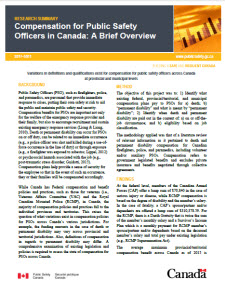
|
Research Summary: Compensation for Public Safety Officers in Canada: A Brief Overview
|
The objective of this project was to: 1) Identify what existing federal, provincial/territorial, and municipal compensation plans pay to PSOs for a) death; b) “permanent disability” and what is meant by “permanent disability”; 2) Identify when death and permanent disability are paid out in the context of: a) on or off-the-job circumstance; and b) eligibility based on job classification.
| 2017-07-07 |
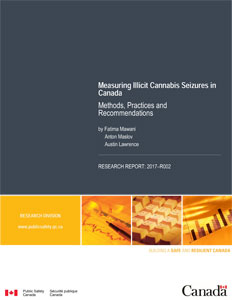
|
Measuring Illicit Cannabis Seizures in Canada
|
The objective of this project is to examine the current methods of measuring the metric of cannabis seizures with particular attention paid to the way seizure information is recorded by law enforcement as well as to discuss the potential improvements to the way we currently measure the metric of cannabis seizures.
| 2017-06-13 |

|
Research Summary - Measuring Illicit Cannabis Seizures in Canada
|
The objective of this project is to examine the current methods of measuring the metric of cannabis seizures with particular attention paid to the way seizure information is recorded by law enforcement as well as to discuss the potential improvements to the way we currently measure the metric of cannabis seizures.
| 2017-06-13 |

|
The Price of Cannabis in Canada
|
The current report provides estimates of: 1) cannabis prices from 2011 to 2015; and 2) the price elasticity of cannabis demand in Canada.
| 2017-06-13 |

|
Research Summary - Price of Cannabis in Canada
|
The current report provides estimates of: 1) cannabis prices from 2011 to 2015; and 2) the price elasticity of cannabis demand in Canada.
| 2017-06-13 |

|
Organized Crime - Research Highlights 2016-H004
|
Criminal Network Disruption; Using Social Network Analysis to Money Laundering Detection; Challenges Faced in Counter Cybercrime Operations; The Structure of Quebec's Synthetic Drug Market; Understanding the Development of Illegal Enterprises
| 2017-06-06 |

|
Research Summary - Youth Gangs in Canada: A Review of Current Topics and Issues
|
Highlighting advances in research on youth gangs and understanding involvement among key populations of interest.
| 2017-05-03 |
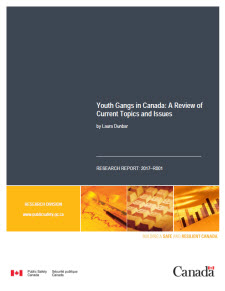
|
Youth Gangs in Canada: A Review of Current Topics and Issues
|
This research report provides an overview of advances that have been made in defining youth gangs and their activities, motivations for joining, and risk and protective factors that influence involvement in a gang lifestyle.
| 2017-05-03 |
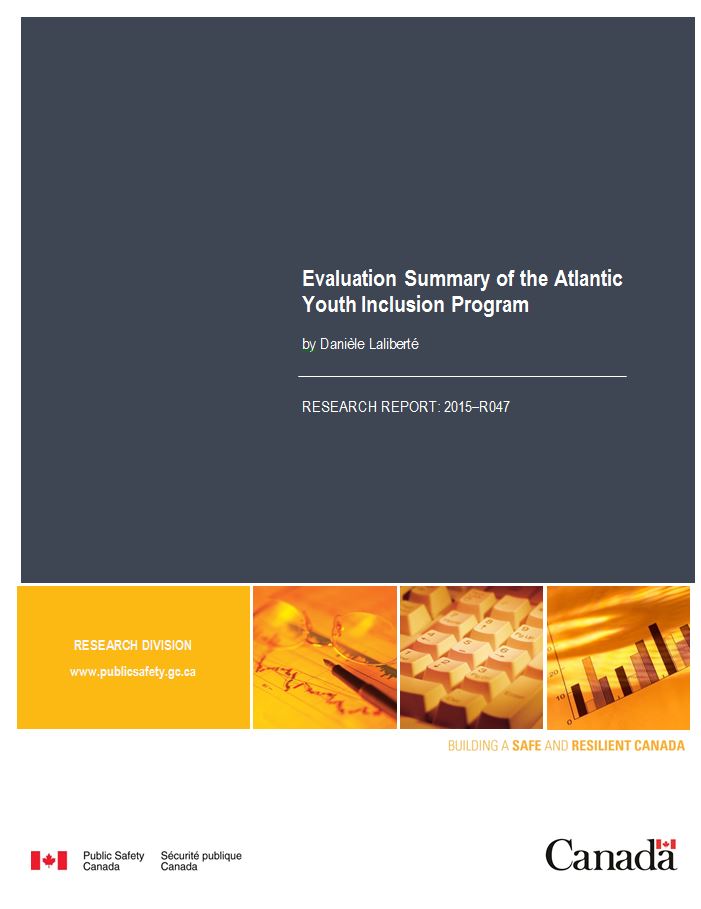
|
Evaluation Summary of the Atlantic Youth Inclusion Program
|
Developed in 2000 by the Youth Justice Board for tackling youth crime in England and Wales, the neighbourhood-based Youth Inclusion Program (YIP) aims to reduce youth crime and anti-social behaviour by creating a safe place where they can learn new skills, participate in activities with others, and receive educational support.
| 2017-01-27 |

|
Costs of Crime and Criminal Justice Responses
|
This report presents a global, comprehensive literature review on the costs of crime and criminal justice responses for the purpose of examining their comparative burdens to society.
| 2016-12-21 |

|
Research Summary: Costs of Crime and Criminal Justice Responses
|
This report presents a global, comprehensive literature review on the costs of crime and criminal justice responses for the purpose of examining their comparative burdens to society.
| 2016-12-21 |

|
Tyler's Troubled Life: The story of one young man's path towards a life of crime
|
This report is a fictional account of a prototypical chronic young offender in Canada. The account does not depict any real persons or events, but is used to illustrate the compounding influence of risk factors on offending, the high costs associated with continued involvement with the criminal justice system, and how such costs can be avoided by investing in evidence-based crime prevention efforts.
| 2016-12-02 |

|
Tyler's Troubled Life - Research Summary
|
This report is a fictional account of a prototypical chronic young offender in Canada. The account does not depict any real persons or events, but is used to illustrate the compounding influence of risk factors on offending, the high costs associated with continued involvement with the criminal justice system, and how such costs can be avoided by investing in evidence-based crime prevention efforts.
| 2016-12-02 |
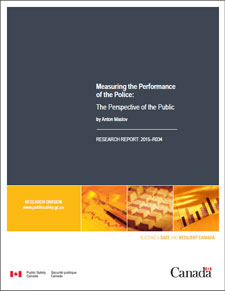
|
Measuring the Performance of the Police: The Perspective of the Public
|
Some key police performance metrics must be gathered through public opinion surveys. Little reliable information of this type is currently collected. Improving the validity and frequency of collected data would enhance police performance measurement.
| 2016-11-18 |
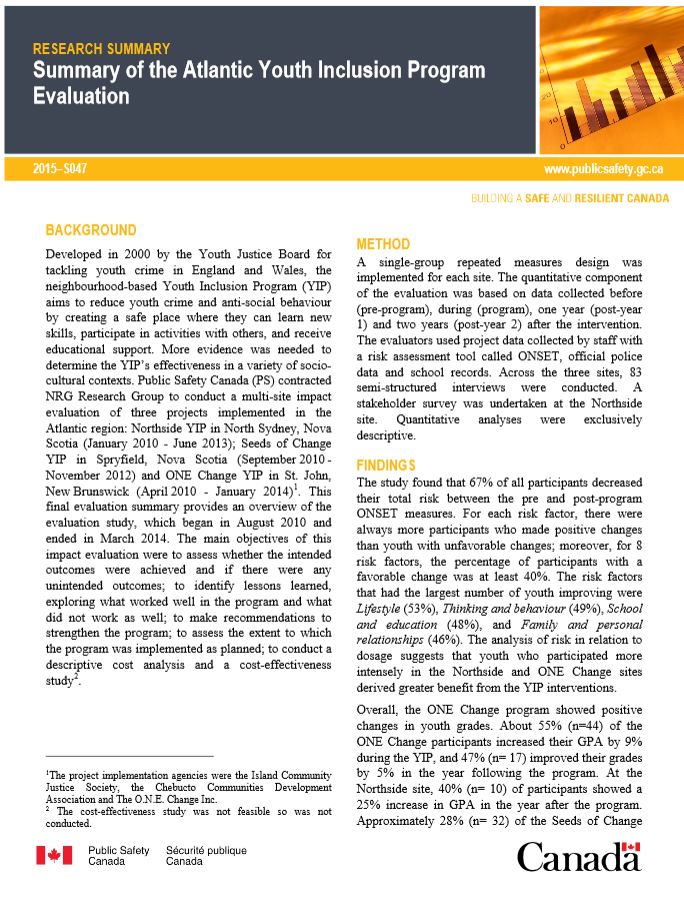
|
Summary of the Atlantic Youth Inclusion Program Evaluation
|
Developed in 2000 by the Youth Justice Board for tackling youth crime in England and Wales, the neighbourhood-based Youth Inclusion Program (YIP) aims to reduce youth crime and anti-social behaviour by creating a safe place where they can learn new skills, participate in activities with others, and receive educational support.
| 2016-09-16 |
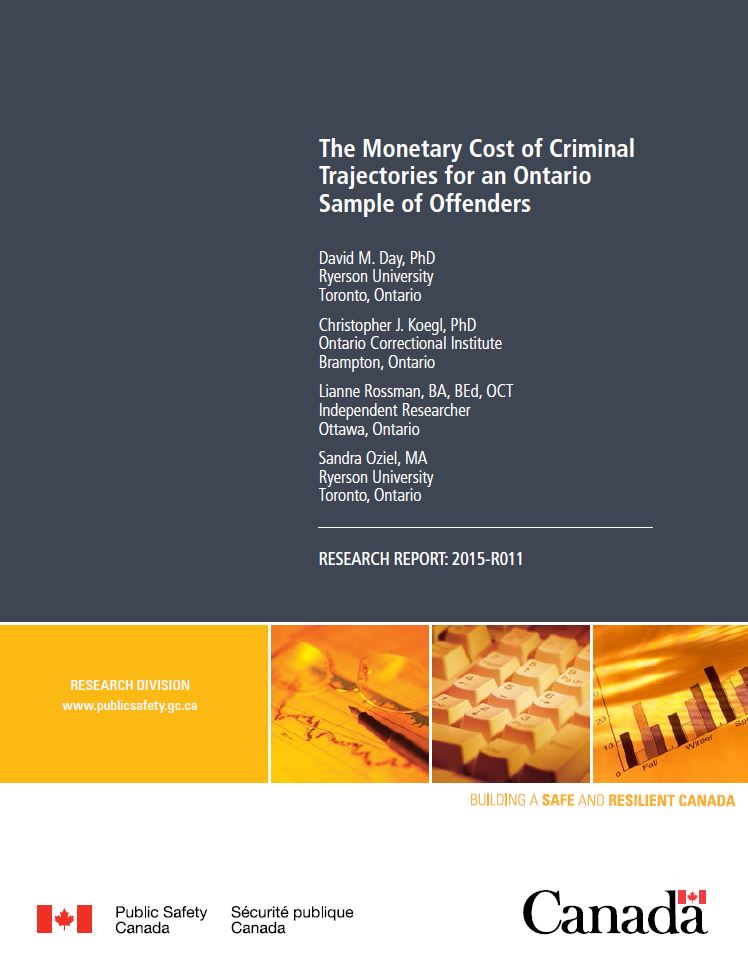
|
The Monetary Cost of Criminal Trajectories for an Ontario Sample of Offenders
|
This research report presents findings on the longitudinal costs of criminal offending for a sample of 386 male offenders in Ontario whose offence costs were tabulated for a 15-year period, between the ages of 12 and 26 years. The information contained in the report is useful for cost benefit analysis, which provides information about what types of crime prevention interventions are the most cost-effective.
| 2016-09-16 |

|
The Monetary Cost of Criminal Trajectories for an Ontario Sample of Offenders - Research Summary
|
This research report presents findings on the longitudinal costs of criminal offending for a sample of 386 male offenders in Ontario whose offence costs were tabulated for a 15-year period, between the ages of 12 and 26 years. The information contained in the report is useful for cost benefit analysis, which provides information about what types of crime prevention interventions are the most cost-effective.
| 2016-09-16 |
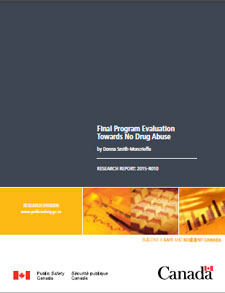
|
Final Program Evaluation – Towards No Drug Abuse
|
Towards No Drug Abuse (TND) is an evidence-based program designed to help youth reduce their tobacco, alcohol or drug use, and violent behaviour.
| 2016-06-24 |
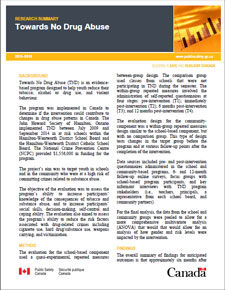
|
Research Summary: Towards No Drug Abuse
|
Towards No Drug Abuse (TND) is an evidence-based program designed to help youth reduce their tobacco, alcohol or drug use, and violent behaviour.
| 2016-06-24 |
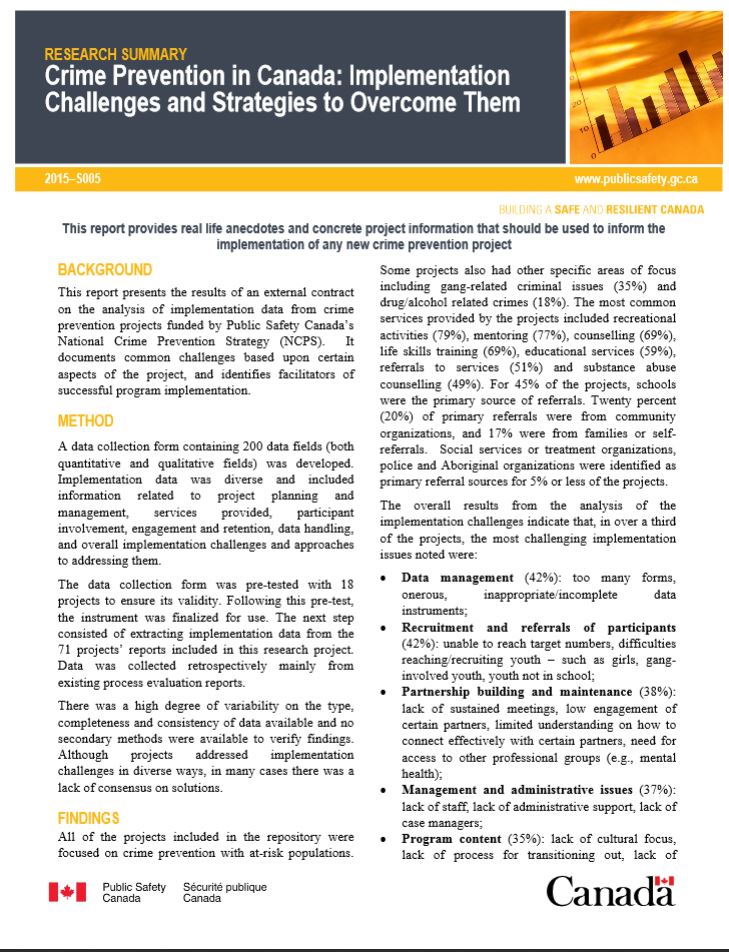
|
Research Summary: Crime Prevention in Canada: Implementation Challenges and Strategies to Overcome Them
|
This report presents the results of an external contract on the analysis of implementation data from crime prevention projects funded by Public Safety Canada's National Crime Prevention Strategy (NCPS).
| 2016-04-21 |
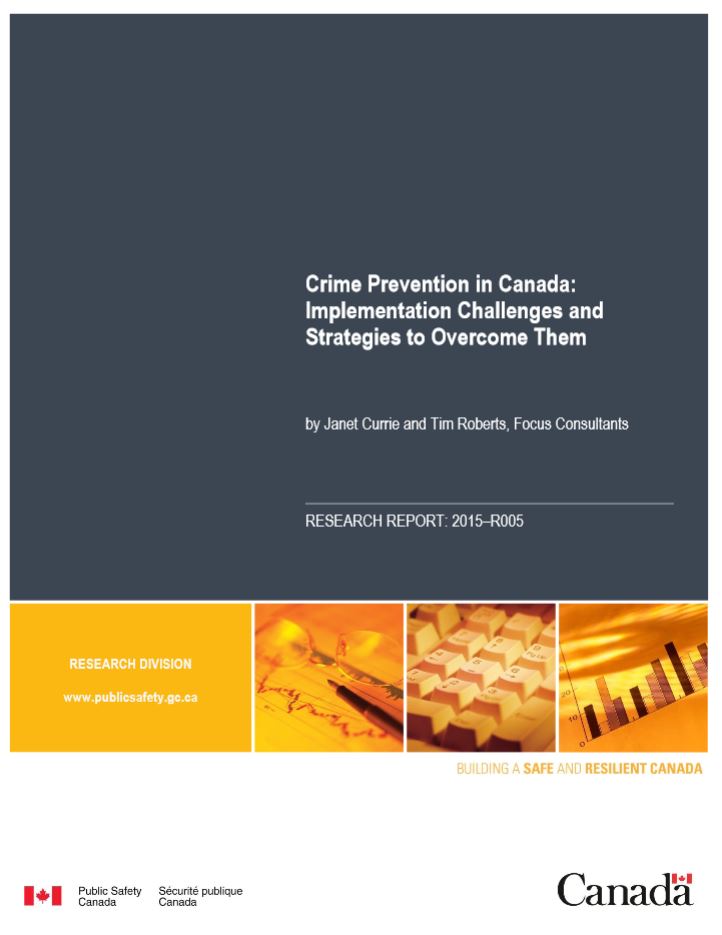
|
Crime Prevention in Canada: Implementation Challenges and Strategies to Overcome Them
|
This report presents the results of an analysis of implementation data from seventy-one crime prevention projects funded by Public Safety Canada's National Crime Prevention Strategy (NCPS).
| 2016-04-21 |

|
Research Summary: Results of Crime Prevention Programs for 12 to 17 Year Olds
|
The research report focuses on the synthesized results of 9 evaluation studies of 10 different crime prevention models implemented for 12 to 17 year olds in 14 sites in Canada and funded under the National Crime Prevention Strategy between 2009 and 2013.
| 2015-07-31 |

|
Results of Crime Prevention Programs for 12 to 17 Year Olds
|
One of the fundamental objectives of Public Safety (PS) Canada's crime prevention activities is to assist those responsible for the implementation and delivery of crime prevention in making the best informed decisions. In order to achieve this objective, Public Safety Canada develops and disseminates practice-oriented knowledge on effective and cost-effective preventative interventions.
| 2015-07-31 |

|
Moving Toward a Stronger Future
|
An Aboriginal Resource Guide for Community Development
| 2015-07-03 |

|
Guide for Selecting an Effective Crime Prevention Program
|
A recent research report, a Guide for Selecting an Effective Crime Prevention Program identifies a four step model to help people in communities select a crime prevention program. Although not exhaustive, it presents some key considerations and questions designed to help people make the most informed decisions possible when selecting a program for implementation in their community.
| 2015-06-15 |

|
Research Summary: Guide for Selecting an Effective Crime Prevention Program
|
A recent research report, a Guide for Selecting an Effective Crime Prevention Program identifies a four step model to help people in communities select a crime prevention program. Although not exhaustive, it presents some key considerations and questions designed to help people make the most informed decisions possible when selecting a program for implementation in their community.
| 2015-06-15 |

|
2013-2014 Evaluation of the Aboriginal Community Safety Development Contribution Program
|
Evaluation supports accountability to Parliament and Canadians by helping the Government of Canada to credibly report on the results achieved with resources invested in programs.
| 2015-03-20 |

|
Guide on the Implementation of Evidence-Based Programs: What Do We Know So Far?
|
Through its National Crime Prevention Centre (NCPC), Public Safety Canada fosters the development and implementation of evidence-based crime prevention interventions in Canada.
| 2015-02-20 |

|
Research Summary: Implementation of Crime Prevention Programs
|
A high-quality implementation is an important determinant in achieving results for evidence-based crime prevention programs
| 2015-02-20 |

|
Building the Evidence – Crime Prevention in Action - The X-Roads Crime Prevention Program (X-Roads)
|
The X-Roads Crime Prevention Project (X-Roads) provided prevention and intervention activities for Aboriginal children and youth aged 6–18 years and at risk of becoming involved in gang activity in The Pas, Manitoba.
| 2015-02-06 |

|
Leadership and Resiliency Program (LRP) - Crime Prevention in Action
|
Public Safety Canada has a mandate to develop and disseminate knowledge of effective crime prevention programs to help decision makers and practitioners across the country make the best use of their crime prevention resources.
| 2015-02-06 |
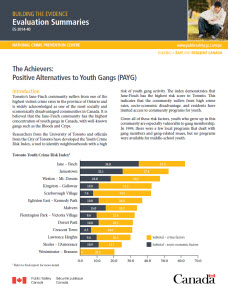
|
The Achievers: Positive Alternatives to Youth Gangs (PAYG)
|
Toronto's Jane-Finch community suffers from one of the highest violent crime rates in the province of Ontario and is widely acknowledged as one of the most socially and economically disadvantaged communities in Canada.
| 2015-01-30 |

|
PréCrimAdo Program
|
In recent years, three youth centres (Québec, Chaudière–Appalaches and Montérégie) and a team of researchers from Laval University collaborated to examine the results of the PréCrimAdo Program (preventing the criminalization of high-risk adolescents).
| 2015-01-30 |

|
Building the Evidence – Project Summaries – LINK –LINKing Refugee Youth and Families to Positive Social Supports
|
LINKing Refugee Youth and Families to Positive Social Supports (LINK) is an innovative program designed to prevent the involvement of refugee youth in criminal and gang-related activity.
| 2014-11-21 |

|
Building the Evidence – Crime Prevention in Action – Walking the Path Together
|
This Crime Prevention in Action provides information on the implementation of the Walking the Path Together Program. It is a culturally based, innovative, five-year program that works with young Aboriginal children aged 6 to 11 and their families to address chronic family violence, the foundation of intergenerational violence, and future offending behaviours. The project is being implemented from July 2009 to March 2014 in the Alberta communities of Wabasca, Morley, Hobbema, Fort Chipewyan and Enilda.
| 2014-09-26 |

|
Building the Evidence – Project Summaries – Strengthening the Spirit
|
This Summary presents what was learned from the implementation of 'Strengthening the Spirit', a prevention program for Aboriginal families at high risk of violent behaviour and contact with the criminal justice system. It was funded by the National Crime Prevention Centre (NCPC) from February, 2009 to September, 2012. It was designed to reduce domestic violence in families, reduce the risk of violence for children, and support families' healing and wellness. The participants came from three First Nations communities near Calgary, Alberta and four Calgary-based organizations serving mainly Aboriginal people.
| 2014-09-26 |

|
Building the Evidence - Project Summaries - Spirit: Girls Identifying Real Life Solutions
|
This summary presents what was learned from the implementation of Spirit, a school-based prevention program for girls from grades 7 to 9 at risk of delinquency and contact with the criminal justice system. It was implemented as a pilot project from September 2008 to August, 2011 in Calgary, Alberta.
| 2014-09-26 |

|
Crime Prevention in Action – LifeSkills Training (LST) Program
|
This Crime Prevention in Action provides information on the implementation of the LifeSkills® Training (LST) Program and the LST projects that the NCPC has supported in locations across Canada. LST is a school-based prevention program that targets early drug and alcohol use by adolescents, especially those in junior high school (grades 6 and 7). The main goals of the LST Program are to prevent substance use amongst adolescents and to promote healthy alternatives to risky behaviour.
| 2014-09-26 |

|
Major Risk Factors for Antisocial and Delinquent Behaviour among Children and Youth
|
The prediction and prevention of crime is grounded on knowledge of its causes. Over the past few decades, considerable efforts in both theory and research have contributed to elucidating these causes. Despite these advances, the causes, and their interplay, of crime and delinquency, as with any human behaviour, remains a complex task.
| 2013-12-20 |

|
Crime Prevention in Action - Stop Now And Plan (SNAP)
|
This Crime Prevention in Action summary provides information on Stop Now and Plan (SNAP) and the SNAP projects Public Safety is supporting in various locations across Canada. It addresses issues to be considered by those interested in implementing a SNAP program.
| 2013-11-08 |

|
Youth Gang Prevention Fund Projects : What Did We Learn About What Works in Preventing Gang Involvement?
|
This Research Report provides a synthesis of key findings from the impact evaluations of 14 youth gang prevention projects implemented in various locations across Canada between 2007 and 2012. It provides a context for Public Safety's NCPC work on youth gangs, briefly describes the funded projects and the approach to conducting the evaluation studies, presents the key findings, and provides some conclusions for moving forward.
| 2013-11-08 |

|
Results from the Stop Now And Plan (SNAP) Program
|
This Evaluation Summary provides preliminary findings from the SNAP program being implemented and evaluated in Toronto, Edmonton and a Cree Nation community in Quebec. SNAP is a community-based program for children under the age of twelve who have come into contact, or are at risk of coming into contact, with the criminal justice system, and who display early signs of anti-social or aggressive behaviour.
| 2013-11-08 |
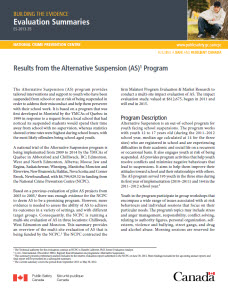
|
Results from the Alternative Suspension (AS) Program
|
This Evaluation Summary provides preliminary findings from the Alternative Suspension (AS) Program being implemented and evaluated in three locations – Chillwack, BC; West Edmonton, AB; and Moncton, NB. The Alternative Suspension (AS) program is designed for youth suspended from school, or at risk of being suspended, and addresses their misconduct while helping them persevere with their school work.
| 2013-11-08 |

|
2012-2013 Evaluation of the Crime Prevention Program
|
Evaluation supports accountability to Parliament and Canadians by helping the Government of Canada to credibly report on the results achieved with resources invested in programs.
| 2013-11-08 |

|
Brief Summaries - Substance Abuse Prevention Projects - Quebec
|
These brief project descriptions provide information on some of the projects funded by Public Safety Canada, NCPC, between 2009 and 2014 that addressed substance abuse as a risk factor for criminal behaviour.
| 2013-10-10 |

|
Brief Summaries - Substance Abuse Prevention Projects - Prairies
|
These brief project descriptions provide information on some of the projects funded by Public Safety Canada, NCPC, between 2009 and 2014 that addressed substance abuse as a risk factor for criminal behaviour.
| 2013-10-10 |

|
Brief Summaries - Substance Abuse Prevention Projects - Ontario
|
These brief project descriptions provide information on some of the projects funded by Public Safety Canada, NCPC, between 2009 and 2014 that addressed substance abuse as a risk factor for criminal behaviour.
| 2013-10-10 |

|
Brief Summaries - Substance Abuse Prevention Projects - North
|
These brief project descriptions provide information on some of the projects funded by Public Safety Canada, NCPC, between 2009 and 2014 that addressed substance abuse as a risk factor for criminal behaviour.
| 2013-10-10 |

|
Brief Summaries - Substance Abuse Prevention Projects - Atlantic
|
These brief project descriptions provide information on some of the projects funded by Public Safety Canada, NCPC, between 2009 and 2014 that addressed substance abuse as a risk factor for criminal behaviour.
| 2013-10-10 |

|
Brief Summaries - Substance Abuse Prevention Projects - British Columbia
|
These brief project descriptions provide information on some of the projects funded by Public Safety Canada, NCPC, between 2009 and 2014 that addressed substance abuse as a risk factor for criminal behaviour.
| 2013-10-10 |
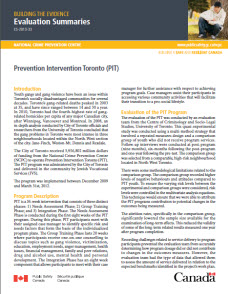
|
Prevention Intervention Toronto (PIT)
|
This Evaluation Summary provides final findings from the Prevention Intervention Toronto (PIT) program. The PIT program was designed to help address the issues of Toronto youth becoming involved in gangs.
| 2013-10-10 |
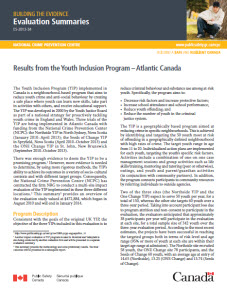
|
Results from the Youth Inclusion Program – Atlantic Canada
|
This Evaluation Summary provides preliminary findings from the three trials of the Youth Inclusion Program (YIP) being implemented to reduce youth crime and anti-social behaviour in Atlantic Canada.
| 2013-10-10 |

|
Results from the Towards No Drug Abuse (TND) Project
|
This Evaluation Summary provides preliminary findings from the Towards No Drug Abuse (TND) program being implemented in the Hamilton Wentworth District School Board in Ontario. The TND program is being implemented to determine if it can contribute to changes in drug abuse patterns among youth.
| 2013-10-10 |

|
Results from the Multisystemic Therapy Program
|
This Evaluation Summary provides preliminary findings from the Multi-Systemic Therapy (MST) program being implemented to address aggressive and socially unacceptable behaviour among at-risk youth in the Scarborough District of Toronto, Ontario.
| 2013-10-10 |

|
Stop Now And Plan (SNAP®) Projects
|
What have we learned about implementing the Stop Now And Plan (SNAP®) Program across Canada?
| 2013-02-01 |

|
Criminal Trajectories of Ontario Adjudicated Youths
|
What are the long-term trends in criminal activity, and the factors associated with the course of offending, of adolescent male offenders in Ontario?
| 2012-11-01 |

|
Implementation Fact Sheets on Promising and Model Crime Prevention Programs - 2012
|
Implementation Fact Sheets on Promising and Model Crime Prevention Programs - 2012
| 2012-10-01 |

|
Velocity Adventure Program (CPA-26)
|
The Velocity Adventure Program (Velocity) is an adventure-based program for youth who are at risk of, or have already been involved in, criminal activity.
| 2012-09-13 |

|
The Offending Trajectories of Youth Probationers from Early Adolescence to Middle Adulthood: Relation to Dual Taxonomies
|
This study sought to identify the distinctive criminal pathways, and specify the early characteristics that predict offending trajectories for a Canadian sample comprised of 514 male and female juvenile probationers followed into middle adulthood.
| 2012-07-12 |
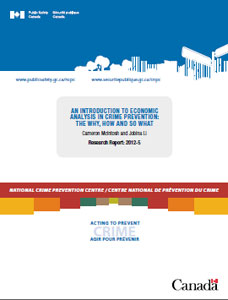
|
An Introduction to Economic Analysis in Crime Prevention: The Why, How and So What
|
An Introduction to Economic Analysis in Crime Prevention: The Why, How and So What
| 2012-07-01 |

|
Risk factors associated with conduct disorder
|
What are the late childhood risk factors associated with conduct disorder in early adolescence, and how are these risk factors specific to particular categories of conduct disorder?
| 2012-07-01 |

|
Durham Youth Gang Strategy
|
In response to the growing gang problem in Durham, the National Crime Prevention Centre, provided $1.5 million to launch the Durham Youth Gang Strategy.
| 2012-06-01 |

|
Gang Prevention Strategy
|
To address the issue of youth gangs, Living Rock Ministries, a non-profit Christian outreach based in downtown Hamilton, delivered the Gang Prevention Strategy (GPS) with approximately 2.3M in funding from the National Crime Prevention Centre.
| 2012-06-01 |

|
Pilot Project to Implement the Looking After Children (LAC) Approach in Québec
|
The Looking After Children project was funded by the National Crime Prevention Centre between March 2004 and February 2009.
| 2012-06-01 |

|
Regina Anti-Gang Services
|
Regina Anti-Gang Services (RAGS) was developed in 2007 in response to the high level of gang activity in the North Central neighbourhood of Regina.
| 2012-06-01 |

|
The Surrey Wraparound: A Youth Driven Plan for Gang Violence Prevention
|
In 2008, the National Crime Prevention Centre's Youth Gang Prevention Fund awarded $808,000 to Surrey School District #36 to implement the Surrey Wrap program.
| 2012-06-01 |

|
Winnipeg Youth Gang Prevention Fund
|
In 2007, Public Safety Canada's National Crime Prevention Centre provided, through its Youth Gang Prevention Fund (YGPF), $2,192,857 in funding to five community-based projects in Winnipeg to deliver services and support to gang-involved youth and those at risk of gang involvement over a three-year period ending March 31, 2011.
| 2012-06-01 |

|
Youth Advocate Program
|
In response to the increased level of gang-related activity, HRM applied to the National Crime Prevention Centre (NCPC) Youth Gang Prevention Fund (YGPF) and subsequently received 1.9 million in funding to implement the Youth Advocate Program (YAP) from 2008-2011.
| 2012-06-01 |

|
Youth Alliance Against Gang Violence
|
In April of 2007, the National Crime Prevention Centre (NCPC) awarded $1,657,141 under the Youth Gang Prevention Fund (YGPF) to the Prince Albert Outreach Program Inc. (PAOPI), a registered non-profit charitable organization, to implement and evaluate the Youth Alliance against Youth Violence program .
| 2012-06-01 |

|
Youth At Risk Development
|
In response to growing concerns about gang violence, the Youth At Risk Development program offered prevention services to high-risk youth and youth involved in gang-related activities in Calgary, Alberta.
| 2012-06-01 |

|
A Statistical Snapshot of Youth at Risk and Youth Offending in Canada NCPC
|
Juvenile delinquency is a complex, multi-faceted issue. In order to devise effective prevention and intervention strategies for youth at risk, it is important to understand the context in which this behaviour occurs.
| 2012-04-16 |

|
The spatial distribution of police-reported youth crime in Toronto
|
How is youth crime distributed in Toronto, and what are the neighbourhood characteristics most strongly associated with this distribution?
| 2012-04-01 |

|
L'Allié: A multimodal approach to remedy behavioural problems and prevent violence in schools
|
L'Allié is a multimodal intervention program intended for students aged 8 to 12 (in Grades 3 to 6 of elementary school) who exhibit externalized behavioural problems, and are at a high risk of school and social maladjustment.
| 2012-03-29 |

|
Late Childhood Risk Factors Associated with Conduct Disorder Subtypes in Early Adolescence: A Latent Class Analysis of a Canadian Sample
|
Very few studies have investigated the association between risk factors in late childhood and subtypes of conduct disorder (CD) in early adolescence that comprise such heterogeneous symptoms as aggression, destruction of property, theft and serious violations of rules.
| 2012-03-28 |

|
Identification and Operationalization of the Major Risk Factors for Antisocial and Delinquent Behaviour among Children and Youth NCPC
|
The objective of this report was to conduct a thorough review of the literature to identify the major risk factors for the onset and maintenance of antisocial and delinquent behaviour in children and adolescents.
| 2012-03-26 |

|
Bamboo Shield (CPA-25)
|
The Bamboo Shield program works with high-risk Aboriginal and immigrant youth between 13 and 17 years old in three schools in Edmonton, Alberta schools.
| 2012-03-23 |

|
Criminal Trajectories of Two Subsamples of Adjudicated Ontario Youths
|
This report presents the findings of three studies conducted on two subsamples of adjudicated Ontario youth. The objective of the studies was twofold: (1) to examine the criminal trajectories of the two subsamples over several follow-up periods; and (2) to identify childhood predictors and adolescent correlates of trajectory group membership.
| 2012-03-09 |

|
A General Overview of Economic Analyses in Crime Prevention
|
How can decision-makers determine the most efficient and cost-effective ways to prevent and reduce crime and victimization?
| 2012-01-01 |

|
MY Regent Park (CPA-20)
|
The MY Regent Park project (Mentoring, Mobilizing Youth in Regent Park)works towards the reduction and prevention of gang activity in the Regent Park community of downtown Toronto.
| 2011-11-09 |

|
The Offending Trajectories of Canadian Juvenile Probationers
|
Can we identify the criminal pathways and characteristics of Canadian youths who are responsible for the vast majority of all offences and the most serious types of crime?
| 2011-11-01 |

|
Families at risk: The impact of the familial environment on juvenile delinquency
|
What are the factors within the family environment that contribute to, or prevent, juvenile delinquency?
| 2011-07-01 |
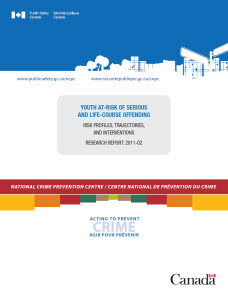
|
Youth At-Risk of Serious and Life-Course Offending
|
This report is based on a review of relevant risk factors that must be taken into consideration when applying interventions to prevent, reduce, or respond to youth at risk of serious and life-course offending.
| 2011-06-22 |

|
Better Beginnings, Better Futures Study: Delinquency Trajectories of At-Risk Youth
|
The objectives of the research were to identify early trajectories of delinquency for both boys and girls from age 8 (Grade 3), age 11 (Grade 6), and age 14 (Grade 9) in a longitudinal sample of at-risk youth from a multi-informant perspective, assess risk and protective factors that may influence the likelihood that youth will engage in criminal behaviour in adolescence, and examine whether youth in the identified delinquency trajectories differ substantially in terms of delinquency, involvement with the criminal justice system, emotional and behavioural problems, experience of abuse, academic/school functioning, and health/health risk behaviours.
| 2011-06-22 |

|
Promising and Model Crime Prevention Programs - Volume II
|
Promising and Model Crime Prevention Programs - Volume II
| 2011-05-01 |

|
Risk Factors for Delinquency among Canadian Youth: Current knowledge and future directions
|
This paper synthesizes existing knowledge from Canadian studies that address delinquency-related risk factors.
| 2011-05-01 |

|
The CRACOW: A Multi-stage Risk/Needs Instrument for Youth
|
Can the CRACOW accurately and reliably assess the risk and needs of multi-problem youth during the early years of development?
| 2011-04-01 |

|
Better to Build a Child than fix an Adult
|
A Report on the Predictors of Risk for Youth Who Proceed to the Adult Justice System and the Programs that Work to Reduce that Likelihood
| 2011-03-31 |

|
The CRACOW Instrument: A New Framework for the Assessment of Multi-problem Violent Youth
|
The current study examined a revised version of the CRACOW, a risk/needs instrument for multi-problem violent youth in early childhood which was first proposed by Corrado (2002).
| 2011-03-26 |

|
Family Adolescent Straight Talk (FAST) - Day Suspension Program
|
Family Adolescent Straight Talk (FAST) is an outpatient treatment centre in Halton Region, Ontario, that helps adolescents and families in crisis. FAST's services include crisis intervention, adolescent assessment, psychological and addictions counselling, parent counselling, anger and stress management programs, and relapse prevention programs.
| 2011-03-15 |

|
Abbotsford Youth Crime Prevention Project (CPA-22)
|
The Abbotsford Youth Crime Prevention Project works with two distinct groups of youth in Abbotsford, British Columbia.
| 2011-02-21 |

|
Effective Community Response to Immigrant Youth Gang Crime (CPA-21)
|
The Effective Community Response to Immigrant Youth Gang Crime Prevention Project provides a comprehensive approach to understanding and reducing the involvement of immigrant youth in gang criminal activity in Calgary.
| 2011-02-21 |

|
Waterloo Regional Gang Prevention Project (CPA-24)
|
The Waterloo Regional Gang Prevention Project is implementing a comprehensive and integrated strategy to address and prevent gang activity among youth in the Waterloo Region.
| 2011-02-21 |

|
Tools to Identify and Assess the Risk of Offending Among Youth
|
Can tools to identify and assess the risk of offending among youth be used and even recommended as part of prevention programs?
| 2011-01-01 |
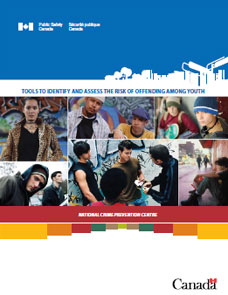
|
Tools to Identify and Assess the Risk of Offending Among Youth
|
This research report presents some of the tools used in the prevention of youth offending.
| 2010-06-01 |

|
Programme de suivi intensif de Montréal – Gangs de rue (CPA-03)
|
The Programme de suivi intensif de Montréal – Gangs de rue (Gangs de rue) project works with teenagers and young adults 15-25 years who are involved in or at high risk of becoming involved in criminal gang activity.
| 2010-03-31 |
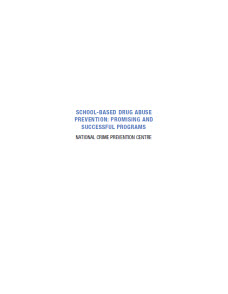
|
School-Based Drug Abuse Prevention: Promising and Successful Programs
|
School-Based Drug Abuse Prevention: Promising and Successful Programs
| 2010-01-27 |

|
The Aboriginal EMPATHIC Program
|
The Aboriginal Emotional Maturity Problem-Solving & Awareness Targeting Higher Impulse Control (EMPATHIC) Program is a school-based curriculum designed for students in grades one to five.
| 2009-12-04 |

|
The Breaking the Cycle Youth Gang Exit and Ambassador Leadership Program
|
The purpose of the evaluability assessment (EA) was to assess and make a determination of whether the BTC program was in a state of program readiness to undergo a rigorous impact and cost-effectiveness evaluation
| 2009-12-01 |

|
Best Practices for Chronic / Persistent Youth Offenders in Canada
|
This report summarizes information collected on the nature and type of community-based, multi-agency and police strategies and programs that exist across Canada for chronic and persistent youth offenders.
| 2009-11-01 |

|
Family-based Programs for Preventing and Reducing Juvenile Crime
|
This fact sheet presents family-based programs for preventing and reducing juvenile crime whose effectiveness has been well established by reliable and rigorous evaluation studies.
| 2009-09-01 |
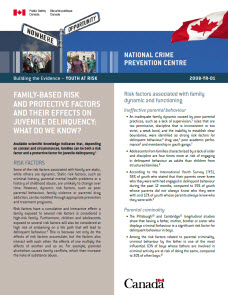
|
Family-Based Risk and Protective Factors and their Effects on Juvenile Delinquency: What Do We Know?
|
Family-Based Risk and Protective Factors and their Effects on Juvenile Delinquency: What Do We Know?
| 2009-09-01 |
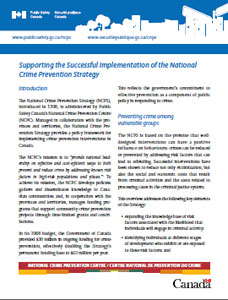
|
Supporting the Successful Implementation of the National Crime Prevention Strategy
|
The National Crime Prevention Strategy (NCPS), introduced in 1998, is administered by Public Safety Canada's National Crime Prevention Centre (NCPC). Managed in collaboration with the provinces and territories, the National Crime Prevention Strategy provides a policy framework for implementing crime prevention interventions in Canada.
| 2009-07-01 |

|
Families, Youth and Delinquency: the State of Knowledge, and Family-based Juvenile Delinquency Prevention Programs
|
Families, Youth and Delinquency: the State of Knowledge, and Family-based Juvenile Delinquency Prevention Programs
| 2009-06-01 |
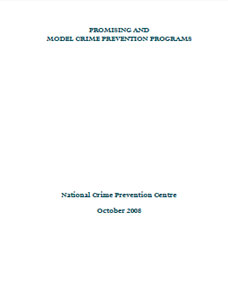
|
Promising and Model Crime Prevention Programs - Volume I
|
This document is part of an ongoing effort at the NCPC to promote and disseminate information and knowledge on effective crime prevention programs, strategies and initiatives.
| 2008-08-01 |

|
Drug Treatment Court of Vancouver (DTCV)
|
The Drug Treatment Court of Vancouver (DTCV) implemented between 2001 and 2005 is based on a model for processing drug addicted offenders that has emerged in the United States and has been adapted to the Canadian context.
| 2008-04-08 |
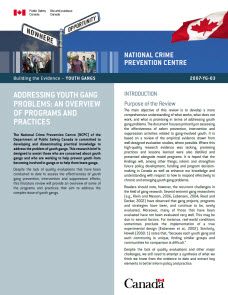
|
Addressing Youth Gang Problems: An Overview of Programs and Practices
|
This research brief is designed to assist those who are concerned about youth gangs and who are working to help prevent youth from becoming involved in gangs or to help them leave gangs.
| 2008-04-01 |
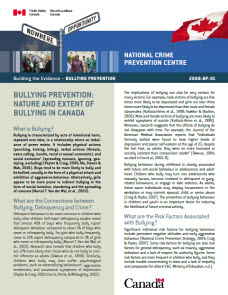
|
Bullying Prevention: Nature and Extent of Bullying in Canada
|
Bullying is characterized by acts of intentional harm, repeated over-time, in a relationship where an imbalance of power exists.
| 2008-04-01 |

|
Middle Schools Project: Families & Schools Together for Children and Neighbourhoods
|
The Middle Schools Project involved implementing the Middle Years F & ST program, an adaptation of the Families and Schools Together (F & ST) model. Middle Years F & ST is aimed at pre-teens (9 to 12 years old) who exhibited risk factors such as family disorganization and isolation, school difficulties, and aggressive behaviour.
| 2008-04-01 |

|
Projet de qualification des jeunes (PQJ)
|
The intensive intervention project (PQJ) to prepare young people for the transition to independent living and ensure that those attending youth centres are qualified is an initiative of the Association des centres jeunesse du Québec.
| 2008-04-01 |

|
Gwich'in Outdoor Classroom Project
|
Gwich'in Outdoor Classroom project was a culture-based crime prevention program in the communities of Fort McPherson and Aklavik, Northwest Territories.
| 2008-01-08 |

|
Healthy Families Project and Kwanlin Dun First Nation's Project
|
The Healthy Families model, which is based on the Healthy Families America program, was tested in five sites across Canada: three sites in Edmonton (Norwood Child and Family Resource Centre, Bent Arrow Traditional Healing Society, and Terra Association), the Kwanlin Dun First Nation Healthy Families Program in Whitehorse, Yukon, and Best Start Healthy Families in Charlottetown, Prince Edward Island.
| 2008-01-08 |

|
Ndaawin Project
|
The Ndaawin Project was a culturally-based intervention aimed at preventing the sexual exploitation of children and youth in Winnipeg.
| 2008-01-08 |

|
National Art and Youth Demonstration Project
|
The National Art and Youth Demonstration Project (NAYDP) was created as an alternative method for child and youth to prevent behaviour problems.
| 2007-11-01 |

|
Program for rapid and intensive intervention for families (PIRIMF)
|
The Programme d'intervention rapide et intensive en milieu familial [Program for rapid and intensive intervention for families] (PIRIMF) is aimed at young people referred to youth protection services on account of serious behavioural problems and their families.
| 2007-11-01 |

|
Project Early Intervention
|
Project Early Intervention (PEI) provided support to high-risk children and youth aged 6 to 12 years, living in a high-needs social housing neighbourhood in Ottawa, Ontario, between 1999 and 2003.
| 2007-11-01 |
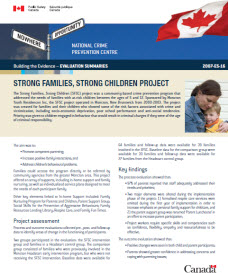
|
Strong Families, Strong Children Project
|
The Strong Families, Strong Children (SFSC) project was a community-based crime prevention program that addressed the needs of families with at-risk children between the ages of 5 and 12.
| 2007-11-01 |

|
First Nations Youth and Restorative Healing Project
|
The First Nations Youth and Restorative Healing Project was a culturally-based community-based crime prevention strategy.
| 2007-06-06 |
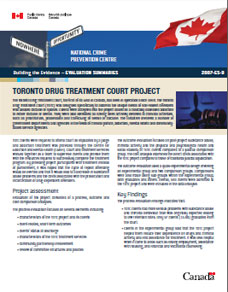
|
Toronto Drug Treatment Court
|
The Toronto Drug Treatment Court, the first of its kind in Canada, has been in operation since 1998.
| 2007-06-06 |

|
Evidence-based crime prevention: Scientific basis, trends, results and implications for Canada
|
Crime prevention policy and practice should be based on solid scientific knowledge and evidence.
| 2007-06-01 |

|
Banyan Community Services SNAP™ Under-12 Outreach Project
|
The Banyan Community Services SNAP™ Under-12 Outreach Project (BCS SNAP™ ORP) is an ongoing program that started in 2003 in Hamilton, Ontario.
| 2007-04-01 |

|
Boundless Adventures project
|
Boundless Adventures was a crime prevention initiative aimed at high-need, under-resourced families with children aged 2 to 6 years in Ontario.
| 2007-04-01 |

|
Domestic Violence Treatment Option court (DVTO)
|
The Domestic Violence Treatment Option court (DVTO) was created in 2000 as a response to the high rates of domestic violence, the victimization First Nations felt from the criminal justice system and the sense that many victims were not reporting domestic violence to police.
| 2007-04-01 |

|
Downtown Eastside
|
The purpose of the project was to mobilize the Downtown Eastside community and build capacity among residents, agencies, and business representatives to address some of the known risk factors for involvement in crime and victimization.
| 2007-04-01 |

|
HomeFront
|
HomeFront was a four-year initiative in Calgary, Alberta. It consisted of a coordinated community response to address the issue of domestic violence.
| 2007-04-01 |

|
Kids 1st Project
|
The Kids 1st Project was a crime prevention program for children 9 to 11 years old.
| 2007-04-01 |
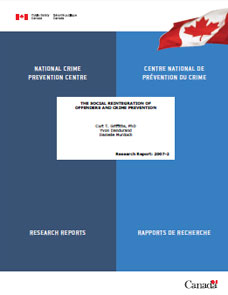
|
The Social Reintegration of Offenders and Crime Prevention
|
Comprehensive crime prevention programs must include effective measures to prevent recidivism and to stop the cycle of failed adaptation by repeat offenders
| 2007-04-01 |

|
Together We Light The Way
|
The Together We Light The Way project was a school-based prevention model implemented in the Durham District School Board Region to respond to the specific needs of children who may engage in anti-social behaviours.
| 2007-04-01 |

|
Youth gang involvement: What are the risk factors?
|
This information sheet is one of a series providing information related to youth gang involvement.
| 2007-04-01 |

|
Youth gangs in Canada: What do we know?
|
This document presents an overview of current knowledge about youth gangs in Canada, including their connections with guns and drugs.
| 2007-04-01 |

|
Strategies for Reducing Gun Violence: The Role of Gangs, Drugs and Firearm Accessibility
|
This report on strategies to reduce gun violence begins with a brief overview of recent trends in gun violence with a particular focus on emerging trends and changes in Canada
| 2007-03-01 |

|
Bullying prevention in schools
|
Bullying Prevention in Schools is a study undertaken by the NCPC on the subject of school-based anti-bullying programs.
| 2005-11-01 |

|
Bullying prevention in schools: Executive summary
|
Bullying Prevention in Schools: Executive Summary is a summary of a study undertaken by the NCPC that reviewed school-based anti-bullying programs, looking at promising practices, results from NCPC-sponsored projects and recommendations for future work in this area.
| 2005-11-01 |

|
First Steps to stop bullying - Adults helping children aged 4-11
|
First Steps to stop bullying - Adults helping children aged 4-11
| 2005-11-01 |

|
First steps to stop bullying - Adults helping youth aged 12-17
|
First steps to stop bullying - Adults helping youth aged 12-17
| 2005-11-01 |

|
Safe and Sound
|
The Safe and Sound project was undertaken in four Ontario neighbourhoods: two in Waterloo, namely Kingsdale and Sunnydale, as well as Southwood and Christopher-Champlain, in Cambridge.
| 2005-10-01 |